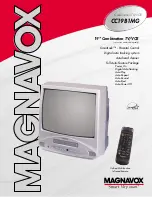
E-9
Head drum
Videotape
Condensation
●
When this unit is moved from a cold to a warm
place abruptly, the vapor in the warm air will come
into contact with the head drum or the tape
guides. When chilled, the vapor turns into drop-
lets of water. This state is known as condensa-
tion. When condensation occurs, the videotape
will adhere to the head drum or the tape guides
and will be damaged.
●
Condensation occurs on this unit in the following
circumstances:
• It is moved abruptly from a cold place to a warm
place.
• It is used in a room immediately after the heater
has been turned on, or when cold breeze from
an air-conditioner blows onto it.
• It is used at a place of high humidity.
●
When condensation occurs, the monitor displays
the following warning:
When a cassette tape is loaded, please do not
transport e.g., from an external cold place to a
warm room thereby subjecting the unit to dras-
tic temperature changes.
After moving the unit, please do not use it until
the innards are stabilized.
To remedy, leave the unit with the power ON and
wait until the WARNING indicator disappears.
●
Prevention of condensation
When transporting the AG-DV2500P from a cold
to a warmer place abruptly, first take out the cas-
sette. Then place the AG-DV2500P in a plastic
bag and seal it before transporting the unit.
Leave the AG-DV2500P in the sealed plastic bag
until the unit has the same temperature as the
surroundings. This will prevent condensation.
CONDENSATION ON DRUM
䡵
For recording and storing videotapes in the best condition
Observe the following instructions for the best recording and storage of videotapes.
●
Take care of the conditions of handling videotapes.
It is recommended that you record and store videotapes in the environment below.
Storage
Recording
Short period
Long period
(Up to 10 years)
(Over 10 years)
Temperature
17°C to 25°C
15°C to 23°C
15°C to 19°C
Humidity
30% to 70%
40% to 55%
25% to 35%
Hourly temperature change
Less than 10°C
–
–
Hourly humidity change
Less than 10%
–
–
●
Do not leave the videotapes neglected for a long period.
If videotapes are left wound for a long period of time, it may result in distortion of the tape. Also it may
cause tape-to-tape adhesion (known as blocking). It is recommended that videotapes be unspooled and
rewound once a year for refreshing.
●
When tapes are not in use, store them in cases and on end.
Storage cases protect videotapes from humidity, dust and ultraviolet. Keep tapes in cases and do not
store them lying flat. When housed in a horizontal position, pressure from other tapes can cause distor-
tions and deformations of the tape edges.










































